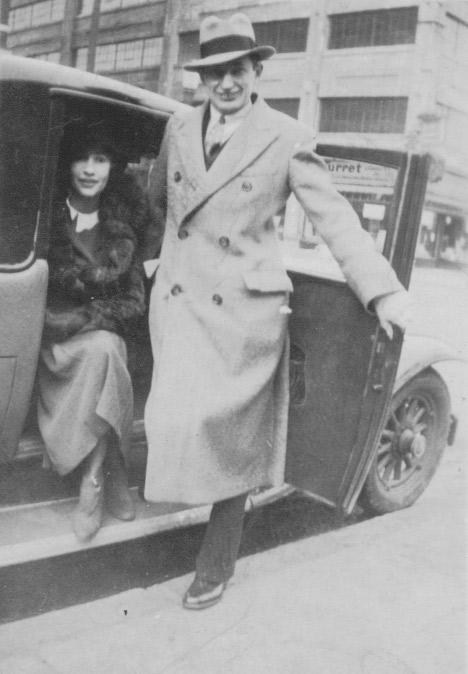A revolution of identity: The Montreal Youth Group
Montreal Youth Group members in 1932. Back row, left to right: Eddie Elliot, Walter Lohse, Emeric Sala, Norman McGregor, Tom Lee and Edward Lindstrom. Second row, left to right: Ruth Cunningham lee, Rosemary Sala, Alberta Sims Dubin, Ilse Lohse, Bahiyyih Lindstrom and Dorothy Wade, From row: left to right: Henry Bergholtz, Mary Maxwell, Glen Wade and Lorris Dear. Photo: from Ilona Weinstien
Every generation faces a new set of needs and requirements in its service to the Cause, altering the role of the Faith in daily decisions and actions. In the late 1920s, a group of youth in Montreal transformed what it meant to live with the teachings of the Faith at the heart of one’s life.
`Abdu’l-Bahá draws the souls together:
From a mere collection of individuals, the Bahá’ís in Montreal acquired, with `Abdu’l-Bahá’s visit to the city serving as the catalyst, a sense of themselves as a community. That community rose from a loose collection of “occasional” Bahá’ís to a people collectively committed to sharing with the wider world its understanding of Bahá’í social principles related to racial amity, world order and Bahá’í administration, while also drawing in people from all backgrounds into the Bahá’í Faith. The Montreal Bahá’í community became the standard bearer of the future directions of many other Bahá’í communities in Canada.
A historical magnifying glass would reveal that, before `Abdu’l-Bahá’s visit, many of the Bahá’ís in Montreal were deeply cemented in the life of the wider society and were making significant personal contributions to that world – often achieving fame or newsworthy mentions in the media of the day – while being a Bahá’í was an addon to their already-established identities. By the time the Master came to Montreal in 1912, these and other few believers were seen as part of the “older generation.” Some disappeared, or drifted away, from the Bahá’ís.
From the end of August to early September of that year, the city was blessed with a nine-day visit from `Abdu’l-Bahá, coordinated by May Maxwell, Who bestowed many treasured moments on the few still involved in the activities of the Faith. Naturally, His presence generated a great deal of attention, not only from the Bahá’ís but the wider community as well. The Master travelled the city and spoke in churches and halls to individuals from all walks of life, drawing people to the teachings of His Father. The abundance of women in the Bahá’í community was noteworthy, as was the relative scarcity of men, and early believers, such as Elizabeth Cowles, would ask `Abdu’l-Bahá to pray that their husbands would accept the new Revelation as well.
Another early believer in Montreal was Dorothy Ward. Born in England and at the age of 17, Dorothy married a widower who had a six-month-old baby. When the couple then emigrated to Canada in 1910, it was owners of a Montreal restaurant who first introduced her to the Bahá’í Faith. Dorothy was, at first, reluctant to take up an invitation by these owners to visit May Maxwell, but finally went. As “she was interested in the people rather than the [Bahá’í] religion,” she thought that the people were “wonderful” and was so “fascinated with them” that in time she became a Bahá’í. Her daughter, Dorothy Wade, became a close friend of Mary Maxwell and was a member of the Montreal Youth Group.
The Montreal Bahá’í Youth Group re-envisions Bahá’í identity:
In 1923, in his first letter to Canada, Shoghi Effendi referred to the country as “vast and flourishing” and “great,” describing its people as “spiritually-minded.” The Guardian also, however, characterized Canadians as “firmly entrenched in their religious sectarianism and strongly attached to their religious doctrines and traditions.”
He then expressed the spiritual mandate of the Bahá’ís to Canadian society and how they could break down the “barriers of prejudice and religious exclusiveness.” More particularly, he insisted that the qualities of “courage and persistence, kindliness and wisdom,” would be required to “conquer this longstanding stronghold of sectarian belief.” The Guardian also raised the vision of Bahá’ís worldwide through his World Order letters.
These letters, and the vision they contained, struck a responsive chord among members of the Montreal Youth Group.[1] In 1927, the newly-emerging group – one of the first its kind in North America – responded with a love and zeal that would take them far beyond the confines of the Montreal Bahá’í community. Until this moment, the community was restricted in membership, temperament, and sometimes had cursory attachments to the Bahá’í Faith, with the exception of some notable Bahá’ís, such as May Maxwell, who saw the wider vision. The formation of a Bahá’í Youth Group in Montreal would alter the way new Bahá’ís would gauge their own relationship with the Bahá’í Faith and its community and would inevitably change the patterns of teaching the Cause. [2]
A young Bahá’í, Rowland Estall, had, through the attraction of May Maxwell and her daughter, Mary, enrolled in the Bahá’í Faith in the waning days of the 1927 National Convention in Montreal. After a summer of working as a wireless operator on ships on the St. Lawrence River, he decided to enroll in Sir George Williams College (now Concordia University). Finding the Bahá’í perspective “considerably more compelling” than the first-year Arts program at university, he teamed up with another young man, Emeric Sala – who had become a Bahá’í in December, 1927[3] – to see whether a youth group could be formed to deepen their understanding of the Bahá’í Faith and to attract other youth to the new religion.
The group charted a new phase for the whole community: one that sought out like-minded organizations, hoping to attract their most active members to the Bahá’í Faith. The meetings of the Bahá’í Youth Group saw its task to unite an understanding of developments in the world with the guidance of Bahá’í teachings. Rather than replicating the tasks of the pre-1912 Bahá’ís who saw their mission to elucidate Christian teachings from the Bahá’í perspective, the Youth Group members had their eyes steadfastly fixed on the requirements of the future as envisioned by Shoghi Effendi. Dorothy Wade shared how the Montreal community responded to this new and entirely unique gathering within the city:
…the Maxwells, of course, set the wonderful example of lovely meetings and youth groups started with Emeric and Rowland, I believe. And suddenly we had about 50 people. People from all walks of life and a lot of communists that would argue. Bahá’ís don’t argue. They thought we were too slow, that things would never happen unless you used force. And all these young people kept coming back and coming back until a lot of them became Bahá’ís.[4]
Within a year, the first to have accepted the Bahá’í Faith through this novel approach was Rosemary Gillies, a young Scottish woman of Presbyterian background, in 1929. There was some hesitancy to ask Gillies to enroll:
Neither Emeric [Sala] or I [Rowland Estall] had had any experience of enrolling anyone in the [Bahá’í] Faith, but one day, in discussing it together, we decided it was high time that Rosemary should be given the opportunity to declare herself. We were not entirely sure of her reaction and so, neither of us wishing to bell the cat, so to speak, we tossed for it. I won, and invited Rosemary to become a Bahá’í. She simply wondered why we had waited so long to ask her.[5]

Rosemary Sala (née Gillis) soon after she declared her faith in Bahá’u’lláh. Photo: contributed by Ilona Weinstein
For these youth, being a Bahá’í was central to their identity and played a decisive role in their futures. Rowland Estall, for example, became one of the most effective teachers of the Bahá’í Faith in Canada. Having given up his university studies, Sun Life Assurance Company hired him, and he became an expert in the new field of group insurance, pensions, and employee benefits. He melded his Bahá’í beliefs with his professional aims, namely the encouragement of profit-sharing plans, security and full benefits for employees, and protecting employees from the financial hazards of death, disability, and old age. His position allowed him to transfer to places, namely Vancouver and Winnipeg, where the Bahá’í community was just emerging or where there were no Bahá’ís at all. By applying the same teaching method as in the Youth Group, he was particularly successful in seeking out like-minded organizations and encouraging their most active leaders and members into Bahá’í membership.
While in Montreal, Rosemary Gillis organized children’s classes every Saturday afternoon. When, in 1934, she married Emeric Sala and moved to St. Lambert, Que., she continued to hold successful classes there, becoming one of the earliest Bahá’í educators of children. She also worked to establish the collection and preservation of archives for the Canadian Bahá’í community. Mr. and Mrs. Sala then pioneered to Venezuela in 1939, helping to bring the Canadian Bahá’í community into contact with the wider world. After the couple settled in Venezuela, the Montreal Bahá’í Youth Group gradually disbanded, with many of its members setting out on their own pioneering trips to teach the Cause across Canada and throughout the world.
The varied experiences of becoming a Bahá’í, as well as the diversity of cultural backgrounds and thought, prepared the Bahá’í community to continually evolve into new patterns of Bahá’í life, guided by `Abdu’l-Bahá, Shoghi Effendi and, today, the Universal House of Justice. It is heartening that, in the late 1920s when the idea of a Bahá’í community was still in its nascent form, the members of the Montreal Bahá’í Youth Group freed themselves from the grasp of society’s norms and focused wholeheartedly on the needs of the Faith: purposefully reaching out to individuals outside of the Bahá’í community, revolutionizing the teaching work and finding enthusiastic response. While the work of this hour is different than that of the Youth Group’s time, the same spirit and determination shown by these young souls, so deeply in love with the Faith, shines out through the faces of the workers of today.
— Will C. van den Hoonaard, with thanks to Ilona Weinstein who helped with this article.
[1] This “youth” group would not fall under the contemporary age bracket of pre-teens and teens, but instead the group pulled in Bahá’ís who were in their twenties at least.
[2] Violette Nakhjavani and Bahiyyih Nakhjavani (2016). The Maxwells of Montreal: Vol 2: Middle Years 1923-1937, Late Years 1937-1952. Oxford, UK: George Ronald.
[3] Ilona Weinstein (2016). Tending the Garden: A Biography of Emeric & Rosemary Sala. Essex, MD: One Voice Press.
[4] From interviews extracted from Will van den Hoonaard (1996), The Origins of the Bahá’í Community of Canada (Waterloo: Wilfrid Laurier University Press)
[5] Ibid.








